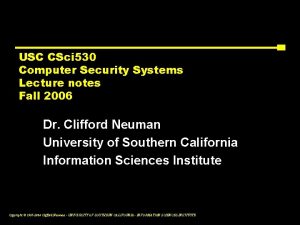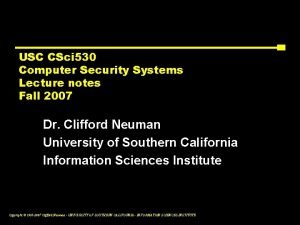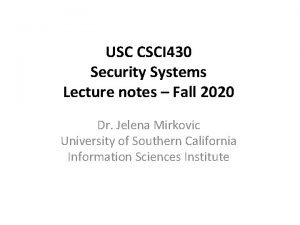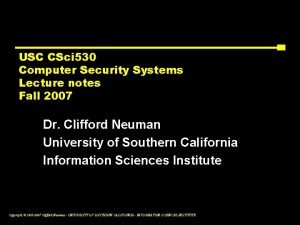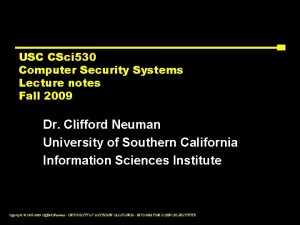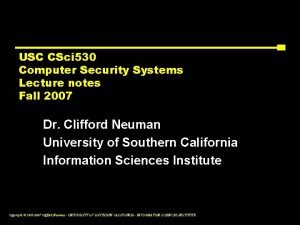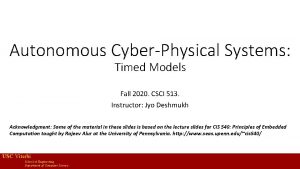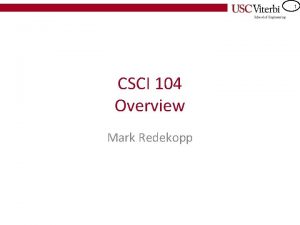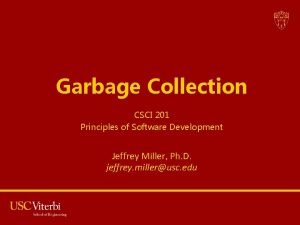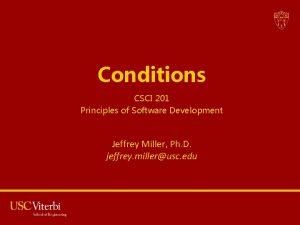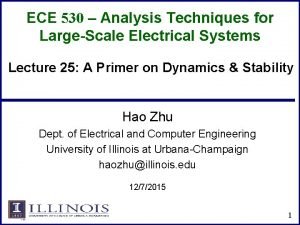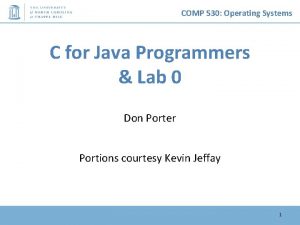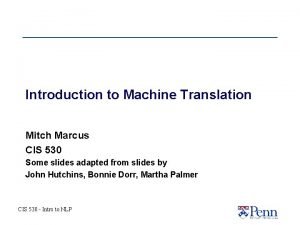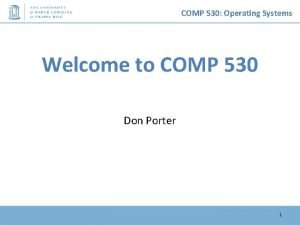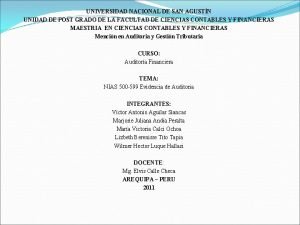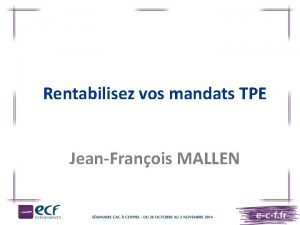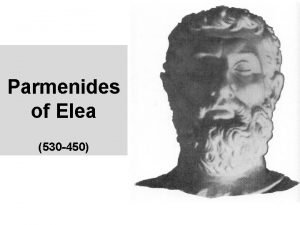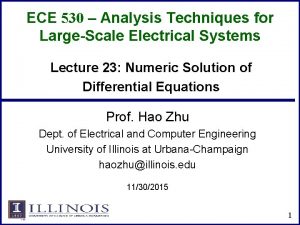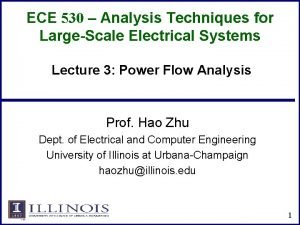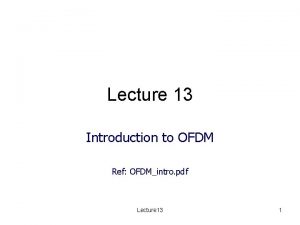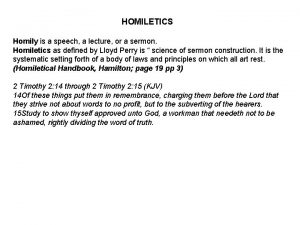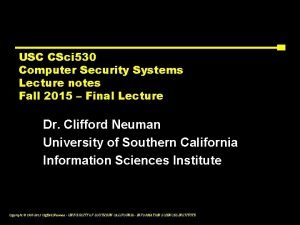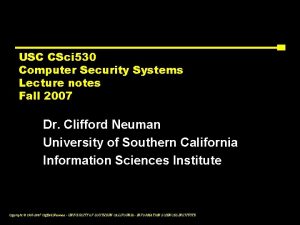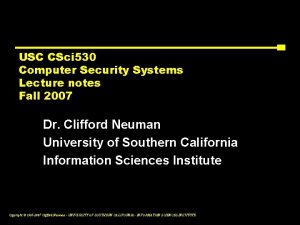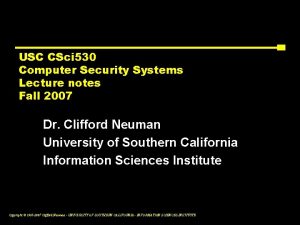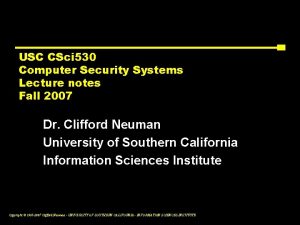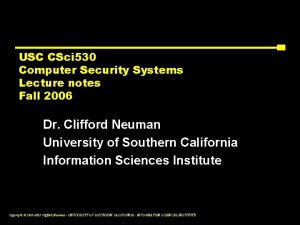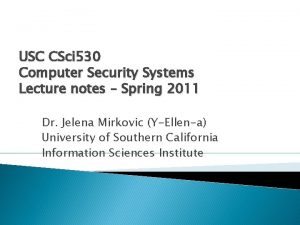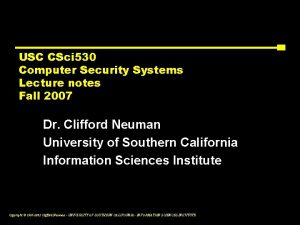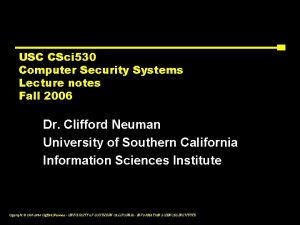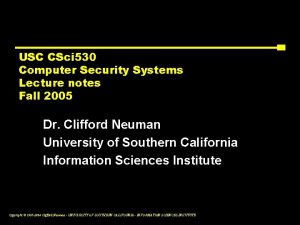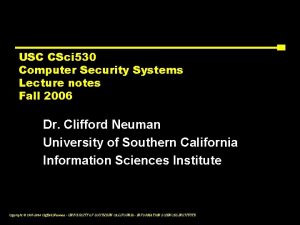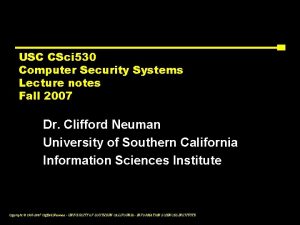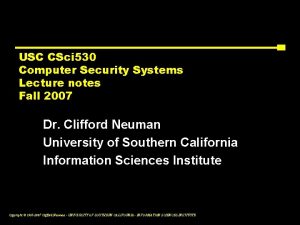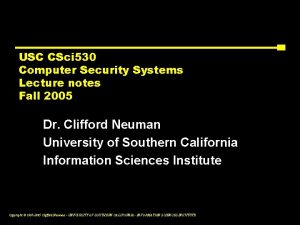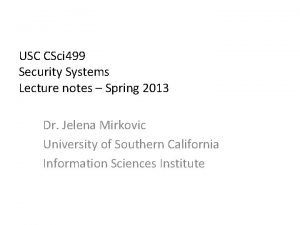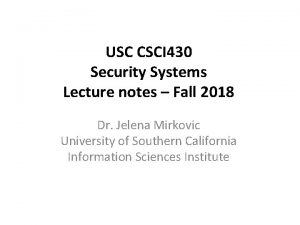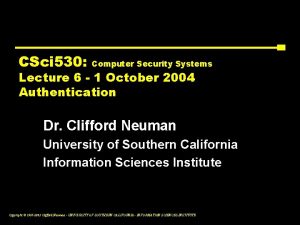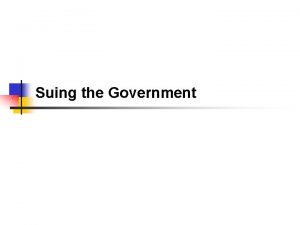USC CSci 530 Computer Security Systems Lecture notes



















































- Slides: 51

USC CSci 530 Computer Security Systems Lecture notes Fall 2007 Dr. Clifford Neuman University of Southern California Information Sciences Institute Copyright © 1995 -2007 Clifford Neuman - UNIVERSITY OF SOUTHERN CALIFORNIA - INFORMATION SCIENCES INSTITUTE

Administrative • Final Exam – Monday December 17 - 11 AM-1 PM – Open Book, Open Note – Room is SGM 123. • Research Paper – Due today (December 7) – Up to one week extension (minor penalty) Copyright © 1995 -2007 Clifford Neuman - UNIVERSITY OF SOUTHERN CALIFORNIA - INFORMATION SCIENCES INSTITUTE

CSci 530: Security Systems Lecture 14 – December 7, 2007 Select Topics in Security Review for Final Dr. Clifford Neuman University of Southern California Information Sciences Institute Copyright © 1995 -2007 Clifford Neuman - UNIVERSITY OF SOUTHERN CALIFORNIA - INFORMATION SCIENCES INSTITUTE

Requested Topics • • Ecommerce Security for High Delay Networks Middleware Security for routing protocols DNS Security Trusted OS implementations Security Case Studies – I’ll use these as a basis for review Copyright © 1995 -2007 Clifford Neuman - UNIVERSITY OF SOUTHERN CALIFORNIA - INFORMATION SCIENCES INSTITUTE

Ecommerce Security • Secure, reliable, flexible, scalable, efficient, and unobtrusive payment methods are required as a basic service of the Internet and must be integrated with existing and evolving applications. Copyright © 1995 -2007 Clifford Neuman - UNIVERSITY OF SOUTHERN CALIFORNIA - INFORMATION SCIENCES INSTITUTE

Reliability • Commerce will depend on the availability of the billing infrastructure. • The infrastructure may be a target of attack for vandals. • The infrastructure must be highly available and should not present a single point of failure. Copyright © 1995 -2007 Clifford Neuman - UNIVERSITY OF SOUTHERN CALIFORNIA - INFORMATION SCIENCES INSTITUTE

Flexibility • Different models for different situations: – credit card, cash, check • Different assurances are provided: – accountability, anonymity, risk • There is a need for a common framework. • Convertibility is needed across models Copyright © 1995 -2007 Clifford Neuman - UNIVERSITY OF SOUTHERN CALIFORNIA - INFORMATION SCIENCES INSTITUTE

Scalability • The payment infrastructure should support multiple independent accounting servers and should avoid central bottlenecks. • Users of different accounting servers must be able to transact business with one another and the funds must be automatically cleared between servers. Copyright © 1995 -2007 Clifford Neuman - UNIVERSITY OF SOUTHERN CALIFORNIA - INFORMATION SCIENCES INSTITUTE

Computational Efficiency • Frequent payments for small amounts must be supported (micropayments). • Performance must be acceptable, even when multiple payments are required. • Merchants and payment servers must be able to handle the load. Copyright © 1995 -2007 Clifford Neuman - UNIVERSITY OF SOUTHERN CALIFORNIA - INFORMATION SCIENCES INSTITUTE

Economic Efficiency • Frequent payments for small amounts must be supported (micropayments). • Per-transaction cost must be small enough that it is insignificant. Copyright © 1995 -2007 Clifford Neuman - UNIVERSITY OF SOUTHERN CALIFORNIA - INFORMATION SCIENCES INSTITUTE

Unobtrusiveness • The payment system should blend into the background. • Users should not be constantly interrupted to provide payment information. • However, users do want to control when, to whom, and how much is paid. • Users must be able to monitor their spending. Copyright © 1995 -2007 Clifford Neuman - UNIVERSITY OF SOUTHERN CALIFORNIA - INFORMATION SCIENCES INSTITUTE

Integration • Payment systems must be tied to the existing financial infrastructure. • Applications must be modified to use the payment infrastructure. • Payments should be supported by common protocols that underlie applications. • A common framework should support integration of multiple payment methods. Copyright © 1995 -2007 Clifford Neuman - UNIVERSITY OF SOUTHERN CALIFORNIA - INFORMATION SCIENCES INSTITUTE

Multiple forms of payment • Secure presentation • Customer registration • Credit-debit instruments • Electronic currency • Server scrip • Direct transfer • Collection agent Copyright © 1995 -2007 Clifford Neuman - UNIVERSITY OF SOUTHERN CALIFORNIA - INFORMATION SCIENCES INSTITUTE

Secure presentation (and non-secure variant) Uses traditional credit card numbers – As safe as the phone (cordless? ) – Potentially huge customer base – Little need for infrastructure Examples - products based on: – Secure Sockets Layer – SHTTP Issues – – No customer signature Legitimacy of merchant Real time authorization Transaction cost Copyright © 1995 -2007 Clifford Neuman - UNIVERSITY OF SOUTHERN CALIFORNIA - INFORMATION SCIENCES INSTITUTE

Customer registration • Customers register and receive passwords, keys, or new account identifiers – Transactions clear through financial service provider who gateways to existing financial system (credit cards or checking accounts) – Protects external account information • Examples: • Issues: – First Virtual – – – Cyber. Cash – – SET Security of system specific credentials Real time authorization Transaction cost Copyright © 1995 -2007 Clifford Neuman - UNIVERSITY OF SOUTHERN CALIFORNIA - INFORMATION SCIENCES INSTITUTE

Credit-debit instruments Financial service provider maintains accounts for customers – – Authorized individuals spend from account. Payment instrument authorizes transfer. Modes: credit like credit card, debit like checks Requires new infrastructure Examples: – CMU’s Net. Bill – USC’s Net. Cheque – FSTC Electronic Check Project Issues – Security of system specific credentials and instruments – Aggregation and tie to financial system – Durability of account information and of provider Copyright © 1995 -2007 Clifford Neuman - UNIVERSITY OF SOUTHERN CALIFORNIA - INFORMATION SCIENCES INSTITUTE

Electronic currency Users purchase currency from currency servers. Currency is presented to merchant who turns it in to currency server. – Potential for anonymity – Possible off line operation Examples: – Net. Cash – Mondex – Digi. Cash – Various stored value cards Issues – Backing of the currency – Level of anonymity – Tamper resistance of hardware– On-line vs. off-line – Who’s at fault for counterfeiting– Storage requirements – Extensive matching capabilities required Copyright © 1995 -2007 Clifford Neuman - UNIVERSITY OF SOUTHERN CALIFORNIA - INFORMATION SCIENCES INSTITUTE

Server scrip • Payment instrument spendable with individual merchants. – Verification of scrip is a local issue – Requires a market and other forms of payment to enable purchase of merchant script. • Examples: – Millicent – Payword • Issues: – Aggregation of purchases improves performance – But must manage many kinds of currency Copyright © 1995 -2007 Clifford Neuman - UNIVERSITY OF SOUTHERN CALIFORNIA - INFORMATION SCIENCES INSTITUTE

Direct transfer • Customer initiates transfer of funds to account of merchant – May result in instrument sent externally • Examples: – Most on-line bill payment mechanisms • Issues – Matching of payment to customer or transaction – Account management similar to credit-debit model Copyright © 1995 -2007 Clifford Neuman - UNIVERSITY OF SOUTHERN CALIFORNIA - INFORMATION SCIENCES INSTITUTE

Collection agent • Merchant refers customer to third party who collects payment and provides receipt. – Receipt is presented to merchant who then provides the goods or services. • Examples: – Open. Market payment switch • Issues – Third party implements the payment methods – Issues are the same as for methods supported Copyright © 1995 -2007 Clifford Neuman - UNIVERSITY OF SOUTHERN CALIFORNIA - INFORMATION SCIENCES INSTITUTE

Some representative systems Available today – – Secure Socket Layer Cyber. Cash SET Open Market Trials – Mondex Demonstrated, but not yet product – – FSTC Electronic Check Net. Cheque Net. Cash Net. Bill No longer with us – First Virtual – Digi. Cash Copyright © 1995 -2007 Clifford Neuman - UNIVERSITY OF SOUTHERN CALIFORNIA - INFORMATION SCIENCES INSTITUTE

Secure socket layer (secure presentation) • Merchant has certified public key • Client submits form with credit card information to merchant encrypted • Merchant obtains authorization for credit card in same manner as for phone order • Availability: Net. Scape Commerce Server, IE, Apache, Open. Market, Others, (Verifone) Copyright © 1995 -2007 Clifford Neuman - UNIVERSITY OF SOUTHERN CALIFORNIA - INFORMATION SCIENCES INSTITUTE

First Virtual (customer registration) • Customer establishes First Virtual account – Customer sends account ID to merchant – Merchant forwards to FV server – FV server verifies through e-mail to customer ▪ Customer can refuse payment to merchant ▪ If too frequent, customer loses account • Issues: – Does not use encryption ▪ No changes to client software ▪ Minimal changes needed for merchant ▪ Known compromise scenario, but of limited use – Exposure limited by delaying payment to merchant (waived for vetted merchants) • Availability: FV (now MAIL) no longer does payments, Customer base sent to Cyber. Cash Copyright © 1995 -2007 Clifford Neuman - UNIVERSITY OF SOUTHERN CALIFORNIA - INFORMATION SCIENCES INSTITUTE

Cyber. Cash (customer registration) • Customer registers credit card with Cyber. Cash and selects signature key – Special software running on client encrypts and signs credit card number and transaction amount and sends to merchant. – Merchant forwards to Cyber. Cash server which obtains authorization and responds to merchant • Issues: – – Credit card number not exposed to merchant Payment clears through credit card system Will adopt SET for credit card payment Cyber. Coin for “micropayments” • Availability: http: //www. cybercash. com Core commercial product is different than described here; does credit card authorizations for merchants. Copyright © 1995 -2007 Clifford Neuman - UNIVERSITY OF SOUTHERN CALIFORNIA - INFORMATION SCIENCES INSTITUTE

Digi. Cash (electronic currency) • Software implementation of electronic currency providing unconditional anonymity – Special software on client implements electronic wallet to store and retrieve currency. – On-line detection of double spending – Post-fact tracking of double spending • Availability: http: //WWW. Digi. Cash. COM – In Chapter 11 reorganization (11/4/98) Copyright © 1995 -2007 Clifford Neuman - UNIVERSITY OF SOUTHERN CALIFORNIA - INFORMATION SCIENCES INSTITUTE

Secure Electronic Transactions (SET) • Customer obtains signature key from card issuer – Special software running on client encrypts and signs credit card number and transaction amount and sends to merchant – Merchant forwards to acquirer which processes transaction through credit card system and responds to merchant with authorization • Advantages – Certification of customer and merchant – Credit card number not exposed to merchant • Disadvantages – Slow encryption – In practice, many are dropping the customer registration requirement • Availability: Part of product offerings by others Copyright © 1995 -2007 Clifford Neuman - UNIVERSITY OF SOUTHERN CALIFORNIA - INFORMATION SCIENCES INSTITUTE

Open Market (collection agent) Provides multi-mechanism collection services for web browsers. – Payment is made to Open Market payment switch. – Switch authorizes delivery of goods. – Added value provided to customer through “smart statement”. Availability: http: //www. openmarket. com M 7, 8 1, 2 Copyright © 1995 -2007 Clifford Neuman - UNIVERSITY OF SOUTHERN CALIFORNIA - INFORMATION SCIENCES INSTITUTE OM 3, 4, 5, 6 + B

Mondex (electronic currency) • Provides smart-card based electronic currency for point of sale and card to card transactions – – – Currency can be accepted off-line Uses a tamper resistant smart card Card signs transactions, so no anonymity Card-to-card transactions using “wallet” Smartcard reader needed to use on network • Availability: several pilots underway, not available yet for Internet transactions Copyright © 1995 -2007 Clifford Neuman - UNIVERSITY OF SOUTHERN CALIFORNIA - INFORMATION SCIENCES INSTITUTE

Electronic Check (credit-debit) v Electronic check provides credit-debit payment instruments that can be sent across the Internet, but which clear through existing banking networks (e. g. . , ACH) – Instrument authenticated Payer using public key cryptography and digital signatures – PCMCIA “electronic checkbook” protects keys – Trial expected in 1997. Payee Remittance Invoice Remittance Check Signature Certificate Payer’s Bank Copyright © 1995 -2007 Clifford Neuman - UNIVERSITY OF SOUTHERN CALIFORNIA - INFORMATION SCIENCES INSTITUTE Check Signature Certificate Endorsement Certificate Payee’s Bank

USC/ISI Net. Cheque ® (credit-debit) • Implements on-line “checking-account” against which payments are authorized. – No prior arrangement between customer and merchant. – A check authorizes the payee to transfer funds from the payor’s account. – Multiple currencies per account. – Payments clear through multiple payment servers. • Availability as research prototype: http: //www. netcheque. org Copyright © 1995 -2007 Clifford Neuman - UNIVERSITY OF SOUTHERN CALIFORNIA - INFORMATION SCIENCES INSTITUTE

Flow of Net. Cheque Payment Instrument Copyright © 1995 -2007 Clifford Neuman - UNIVERSITY OF SOUTHERN CALIFORNIA - INFORMATION SCIENCES INSTITUTE

Net. Cheque representation • Internal representation is opaque • Important fields: – Account and accounting server – Amount, payee, expires – Customer and merchant info – Signatures and endorsements • MIME encoded for use by applications • Applications display checks according to their own requirements. – Display check makes it look like check – Statement displays one line per check • Statement API returns entire check with endorsement – Allows easy import of information from check into users financial applications. Copyright © 1995 -2007 Clifford Neuman - UNIVERSITY OF SOUTHERN CALIFORNIA - INFORMATION SCIENCES INSTITUTE

Net. Cheque Payment Instrument --Net. Cheque(SM)V 1. 0 Content-Type: APPLICATION/X-NETCHEQUE Content-Transfer-Encoding: BASE 64 Content-Description: Pay 10. 00 NCU to marketplace@NETCHEQUE. ISI. EDU AAAAAQAAAA 5 OZXRDa. GVxd. WVf. Vj. Eu. MAAAAA 1 TT 0 ZUV 0 FSRV 9 WMS 4 x. AAAAAQED NTE 4 Az. I 2 N 2 GCAQcwgg. EDo. AMCAQWh. Exs. RTk. VUQ 0 h. FUVVFLkl. TSS 5 FRFWi. KTAn o. AMCAQGh. IDAe. Gwl. OZXRDa. GVxd. WUb. EW 5 ld. GNo. ZXF 1 ZS 5 pc 2 ku. ZWR 1 o 4 G 7 MIG 4 o. AMCAQGh. Aw. IBAa. KBqw. SBq. EILdn. GDj 8 taheicu 2 b 3 DK+0 q. YB+ay. Ety. ZUd. Vsy. C RVFVRS 5 JU 0 ku. RURVAAAABQAAAAIBM 05 DVQEx. ATEAAAAEAj. U 5 AAAACwk 4 MDAw Mz. Q 4 Nzk. JODAy. MTk 0 Nzk 4 AAAACQIx. NUNsa. WZmb 3 Jk. X 05 ld. W 1 hbg. AAAAEBMQEx AAAAHW 1 hcmtld. HBs. YWNl. QE 5 FVENIRVFVRS 5 JU 0 ku. RURVAAAAAA== --Net. Cheque(SM)V 1. 0 -- Copyright © 1995 -2007 Clifford Neuman - UNIVERSITY OF SOUTHERN CALIFORNIA - INFORMATION SCIENCES INSTITUTE

Net. Cheque security • Check has plaintext part and signature • Endorsements are separately signed and linked to a particular check • Signature component is modular – Current implementation is Kerberos proxy ▪ Signature verifiable by customer’s bank – Can accommodate RSA or DSS signatures Copyright © 1995 -2007 Clifford Neuman - UNIVERSITY OF SOUTHERN CALIFORNIA - INFORMATION SCIENCES INSTITUTE

Clearing funds through multiple servers AS 3 accounts: AS 1, AS 2 AS 1 AS 2 accounts: AS 3, S 1, CS 1 accounts: AS 3, U 2, CS 2 <check> AS: Accounting Server U: User U 2 S: Service Provider Copyright © 1995 -2007 Clifford Neuman - UNIVERSITY OF SOUTHERN CALIFORNIA - INFORMATION SCIENCES INSTITUTE

Placement of Net. Cheque servers • Banks and other fiduciaries – To pay checks written against customer accounts. • Grantors of credit – Pay checks, and collect from customer later. • Merchants – To track purchases on house accounts. • Customers – To allow checks to be cleared directly against budget lines on customer’s books. Copyright © 1995 -2007 Clifford Neuman - UNIVERSITY OF SOUTHERN CALIFORNIA - INFORMATION SCIENCES INSTITUTE

USC/ISI’s Net. Cash • Users purchase currency from currency server using Net. Cheque - deposits to currency server’s account back the currency • Supports weakly anonymous payment – Cash can be exchanged for new cash anonymously – Customer chooses the currency server • Multiple currency servers, the Net. Cheque system is used to clear cross-server payments Copyright © 1995 -2007 Clifford Neuman - UNIVERSITY OF SOUTHERN CALIFORNIA - INFORMATION SCIENCES INSTITUTE

The risks of electronic commerce • The customer’s perspective – Stolen payment credentials & passwords – Dishonest merchants – Disputes over service quality – Dishonest financial service providers – Inappropriate use of transaction details Copyright © 1995 -2007 Clifford Neuman - UNIVERSITY OF SOUTHERN CALIFORNIA - INFORMATION SCIENCES INSTITUTE

The risks of electronic commerce • The merchant’s perspective – Forged or copied instruments – Disputed charges – Insufficient funds in customer account – Unauthorized redistribution of purchased items – Dishonest financial service providers – Slow payment by financial service provider Copyright © 1995 -2007 Clifford Neuman - UNIVERSITY OF SOUTHERN CALIFORNIA - INFORMATION SCIENCES INSTITUTE

The risks of electronic commerce • The financial service provider’s perspective – Deadbeat account holders – Disputed charges to outside accounts – Disputed merchant charges – Fly-by-night merchants – Stolen customer or service credentials – Forged or copied instruments Copyright © 1995 -2007 Clifford Neuman - UNIVERSITY OF SOUTHERN CALIFORNIA - INFORMATION SCIENCES INSTITUTE

Offloading the risks • Limiting exposure to risk – Credit vs. debit model for accounts – Deferring payment to merchants • Shifting risk to other parties – Agreements shifting risk to merchant – Regulations protecting the consumer – Insurance - perhaps as higher transaction fees Copyright © 1995 -2007 Clifford Neuman - UNIVERSITY OF SOUTHERN CALIFORNIA - INFORMATION SCIENCES INSTITUTE

Technical solutions • Protecting payment credentials – Token cards – Smart cards • On-line authorization – Detects double spending – Checks for sufficient funds – Enables checks for spending patterns • Tagging documents Copyright © 1995 -2007 Clifford Neuman - UNIVERSITY OF SOUTHERN CALIFORNIA - INFORMATION SCIENCES INSTITUTE

Security in High Delay Networks • Requirement is to reduce round trip times • This may limit usability of online intermediary – Depends on who contacts it – Usually no verifier initiated actions • Credentials usually pushed with request – Consider NS vs Kerberos Copyright © 1995 -2007 Clifford Neuman - UNIVERSITY OF SOUTHERN CALIFORNIA - INFORMATION SCIENCES INSTITUTE

Security For Middleware • DCOM, CORBA, RPC, etc • Issues – Authentication in underlying protocols – Confidentiality and integrity – Delegation – Management Copyright © 1995 -2007 Clifford Neuman - UNIVERSITY OF SOUTHERN CALIFORNIA - INFORMATION SCIENCES INSTITUTE

Security in Routing • Routing is a peer to peer system • Topology is dynamic – (otherwise we would not need routing protocols) • Routing is Transitive • Security through Signing updates • Policy is the hard part • Systems SIDR, SBGP, etc Copyright © 1995 -2007 Clifford Neuman - UNIVERSITY OF SOUTHERN CALIFORNIA - INFORMATION SCIENCES INSTITUTE

Domain Name System Security • Unauthenticated responses • Cache poisoning • DNS Sec addresses these issues – Zones and records are signed – Management issues Copyright © 1995 -2007 Clifford Neuman - UNIVERSITY OF SOUTHERN CALIFORNIA - INFORMATION SCIENCES INSTITUTE

Trusted Operating Systems – Virtualization vs Careful Coding – SELinux ▪ Linux with support for MAC ▪ Does not address assurance – Trusted Solaris ▪ Solaris with MAC and RBAC Copyright © 1995 -2007 Clifford Neuman - UNIVERSITY OF SOUTHERN CALIFORNIA - INFORMATION SCIENCES INSTITUTE

Hypothetical Case Studies • Past exams – Electronic voting (Fall 2004) – Medical records (Fall 2003) – Intrusion Detection and Response (Fall 2005) Copyright © 1995 -2007 Clifford Neuman - UNIVERSITY OF SOUTHERN CALIFORNIA - INFORMATION SCIENCES INSTITUTE

Electronic Voting You have been asked to design a system to support the collection and counting of votes for the next election. In particular, you have been asked to design a system that will accurately tabulate votes entered by voters at poling places throughout the state and to transmit those votes to the county clerk of each county where the totals will be tabulated. (a) Threats. What are threats in such a system? What can go wrong? (b) Requirements. What are the requirements for authentication, authorization, assurance, audit, and privacy? Explain who and what must be authenticated, what authorizations are required, what assurance is needed for the software, and what kind of records must be maintained (as well as what kinds of records should not be maintained). (c) Considering the requirements listed above, and how they relate to the assurance problem, i. e. how can steps taken for authentication, authorization and audit be used to ensure that the software has not been modified to improperly record or transmit votes? (d) What technologies proposed for digital rights management be used to provide stronger assurance that the system’s integrity has not been compromised. What is similar about the two problems, and how would such technologies be applied to the voting problem. Copyright © 1995 -2007 Clifford Neuman - UNIVERSITY OF SOUTHERN CALIFORNIA - INFORMATION SCIENCES INSTITUTE

Medical Records • You have been hired as a consultant to advise on the design of a security mechanism that will be used to protect patient data in a new medical records system. This system will manage and support the transmission of patient records, including very large images files for X-rays, MRI, CAT-scans and other procedures. The system must provide appropriate levels of protection to meet HIPAA privacy regulations, and it must allow the access to records needed by physicians and specialists to which patients are referred. (a) Describe appropriate requirements for confidentiality, integrity, accountability, and reliability/availability in such a system. (b) In what part's) of the system (e. g. , where in the protocol stack would you include support for each of the requirements identified in (a)? Why would you place mechanisms where you suggested; what were the issues you considered? (c) What security mechanisms and approaches to implement those mechanisms would you use to meet the requirements in (a) as implemented in the parts of the system you identified in (b)? Copyright © 1995 -2007 Clifford Neuman - UNIVERSITY OF SOUTHERN CALIFORNIA - INFORMATION SCIENCES INSTITUTE

Intrusion Detection and Response • You have been asked to design a system that will provide effective response to new attacks. The system you design will have two components, an intrusion detection component designed to detect attacks, and a dynamic policy enforcement mechanisms that will dynamically adjust policies based on what is learned about attacks from the intrusion detection component. Your system is supposed to provide an effective defense against viruses, worms, as well as attacker targeted penetration attempts to the systems in your organization. Copyright © 1995 -2007 Clifford Neuman - UNIVERSITY OF SOUTHERN CALIFORNIA - INFORMATION SCIENCES INSTITUTE
 Csci 530 security systems
Csci 530 security systems Csci 530
Csci 530 Csci 430 usc
Csci 430 usc Csci 530 usc
Csci 530 usc Pinstir
Pinstir Csci 530
Csci 530 Csci 513
Csci 513 Csci 104 usc
Csci 104 usc Usc csci 201
Usc csci 201 Csci 201 usc
Csci 201 usc 01:640:244 lecture notes - lecture 15: plat, idah, farad
01:640:244 lecture notes - lecture 15: plat, idah, farad Advanced operating system notes
Advanced operating system notes Computer aided drug design lecture notes
Computer aided drug design lecture notes Architecture lecture notes
Architecture lecture notes Computer security 161 cryptocurrency lecture
Computer security 161 cryptocurrency lecture Private secruity
Private secruity Ece 530
Ece 530 Comp 530
Comp 530 Bioc 530
Bioc 530 Cis 530 upenn
Cis 530 upenn Comp 530
Comp 530 Nia 580
Nia 580 Nep 315
Nep 315 530+450
530+450 Ece 530
Ece 530 Ece 530
Ece 530 Ar 530-1
Ar 530-1 Project procurement management lecture notes
Project procurement management lecture notes Theology proper lecture notes
Theology proper lecture notes Lecture notes on public sector accounting ghana pdf
Lecture notes on public sector accounting ghana pdf Project management lecture
Project management lecture Magnetism
Magnetism Physics 111 lecture notes
Physics 111 lecture notes Physical science lecture notes
Physical science lecture notes Power system dynamics and stability lecture notes
Power system dynamics and stability lecture notes Microbial physiology and metabolism lecture notes
Microbial physiology and metabolism lecture notes Mechatronics notes ppt
Mechatronics notes ppt Limits fits and tolerances
Limits fits and tolerances Money-time relationship and equivalence
Money-time relationship and equivalence Current components in bjt
Current components in bjt Software engineering lecture notes
Software engineering lecture notes Ofdm lecture notes
Ofdm lecture notes Land use planning lecture notes
Land use planning lecture notes Project management lecture notes doc
Project management lecture notes doc Lecture notes on homiletics
Lecture notes on homiletics Foundation engineering lecture notes
Foundation engineering lecture notes Image processing lecture notes
Image processing lecture notes Intermediate microeconomics lecture notes
Intermediate microeconomics lecture notes Parallel and distributed computing lecture notes
Parallel and distributed computing lecture notes Decision theory lecture notes
Decision theory lecture notes Nonlinear regression lecture notes
Nonlinear regression lecture notes Advanced inorganic chemistry lecture notes
Advanced inorganic chemistry lecture notes
